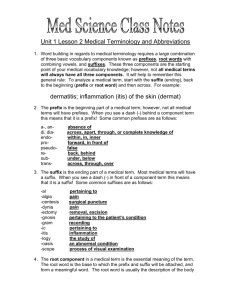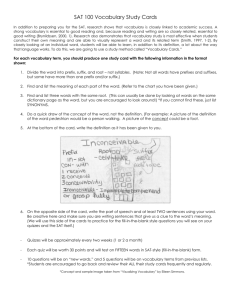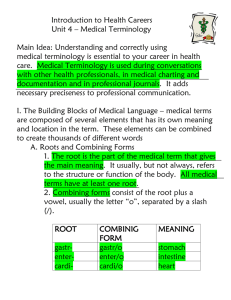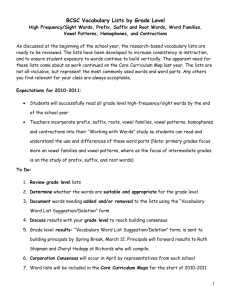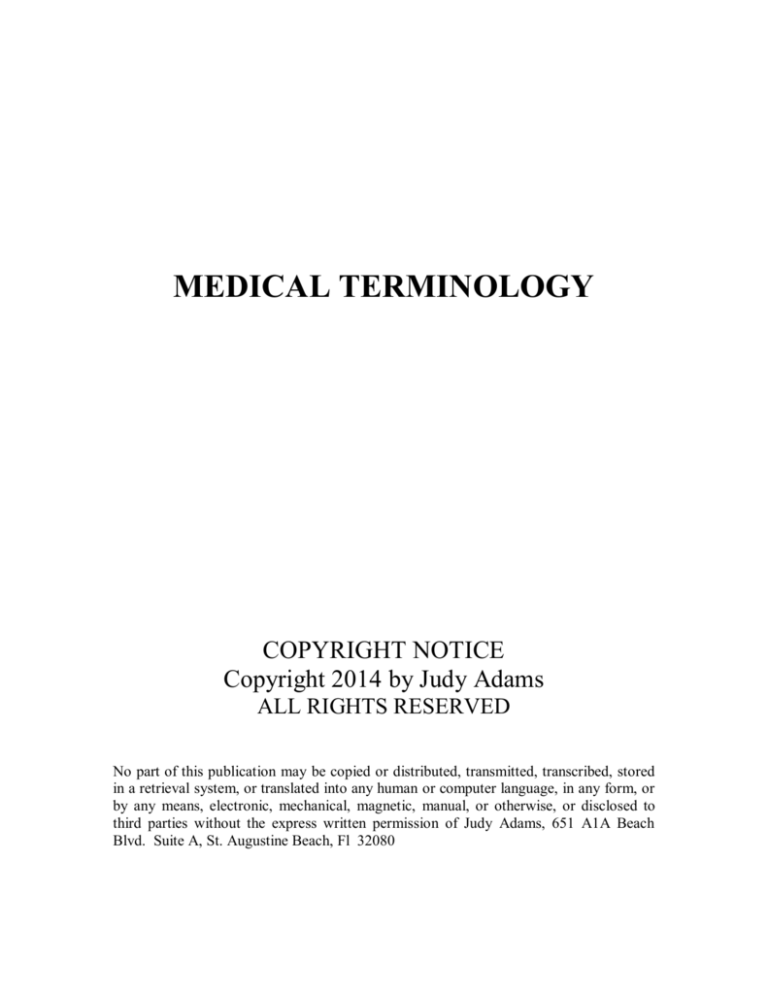
MEDICAL TERMINOLOGY
COPYRIGHT NOTICE
Copyright 2014 by Judy Adams
ALL RIGHTS RESERVED
No part of this publication may be copied or distributed, transmitted, transcribed, stored
in a retrieval system, or translated into any human or computer language, in any form, or
by any means, electronic, mechanical, magnetic, manual, or otherwise, or disclosed to
third parties without the express written permission of Judy Adams, 651 A1A Beach
Blvd. Suite A, St. Augustine Beach, Fl 32080
Preview
Goals and Objectives:
As allied health professionals we have moved into a more medical realm, and our need
for a strong medical vocabulary has become greater. Since it would be impossible to
memorize all of the terms with which you must become familiar, it will be an easier task
to master if you understand more about the way medical terms are combined or put
together. Smaller pieces of words are joined together to build a meaning. If you can
understand the basics of the small parts, then it will be easier to decipher the meaning of
words that are unfamiliar to you. This home study unit will concentrate on medical terms
that you will commonly use when communicating with other professionals in the health
care industry.
When you complete this study unit you will be able to:
Identify many of the common roots, prefixes, and suffixes that are used in the hair
removal profession
Determine the meaning of medical terms by analyzing their component parts
Familiarize yourself with medical specialties
Learn the correct pronunciation of medical words
2
Using this study unit:
So you will be able to learn the correct pronunciation of these medical terms, a phonetic
spelling of each new word will be included in the material. You will find this phonetic
spelling in parenthesis after the term. The basic rules are fairly simple.
1. Vowel sounds that are marked with a straight line above them are called ‘long’
vowel sounds. For example the phonetic spelling of mate is māt, the phonetic
spelling of bite is bīt, the phonetic spelling of home is hōm, and so on.
2. Short vowel sounds are marked with a breve (˘) over them. Therefore, the
phonetic spelling of bat is băt, the phonetic spelling of met is mĕt, the phonetic
spelling of bit is bĭt, and so on.
3. The primary stress in a word is indicated by a single boldface accent (’) and the
secondary stress is indicated by a double lightface accent (”).
ă as in măp
ā as in lāke
ě as in bět
ē as in rēflex
ĭ as in lĭp
ī as in pīe
ŏ as in hŏt
ō as in nō
ŭ as in hŭg
ū as in ūnion
oo as in booth
oy as in boy
3
Contents:
Section 1:
Preview
Goals and Objectives
Using this Study Unit
Introduction
Word Analysis
Suffixes
Prefixes
Root Words and Their Combining Forms
Lists of commonly used prefixes and suffixes
Check your Knowledge Answers
Examination
4
HOW MEDICAL TERMINOLOGY IS USED
Introduction
Medical vocabulary originates from Greek and Latin. Much of our medical language
comes from Hippocrates, the “Father of Medicine”. He was a Greek physician in the
fourth century B.C. and was the author of the Hippocratic oath. Since most medical
terms are compound English derivatives of Latin and Greek it is impossible to always
achieve a word for word translation.
Although medical terminology is primarily compiled from ‘dead’ languages, it is as much
a living language as English! Hundreds of new words are born into it and hundreds die
of disuse in each medical generation. New medical words are always being created, and
it should come as no surprise that learning medical technology is very similar to learning
a foreign language.
Medical words are not monotonous. Each separate syllable holds a meaning. A mixture
of roots from both languages, or a Greek prefix to a Latin stem is common. These words
are called hybrids.
EPILEPTIFORM
ENDOCERVICITIS
EXTRASYSTOLE
(Gr. Epileptos, L. forma)
(Gr. Endon, L. cervix, Gr. itis)
(L. extra, Gr. systole)
Listed below are some common body parts, with their Latin and Greek terms.
PART
LATIN
GREEK
DISEASE
Skin
Gland
Breast
Muscle
Stomach
Womb
Cutis
Glandula
Mamma
Musculus
Stomachus
Uterus
Derma
Aden
Mastos
Mys
Gaster
Metra
Dermatitis
Adenitis
Mastitis
Myositis
Gastritis
Metritis
To accurately interpret a medical term, you may need to consult a good medical
dictionary.
Learning another language is not just a matter of memorizing the new words, but of
learning the rules that govern it. The order in which a word is constructed will affect its
meaning. Take a look at the following English sentences and you will see how important
order can be.
5
The ball hit John
Hit John the ball.
Hit the ball, John.
Now, take a look at how much punctuation can change the meaning of the following
sentence.
John hit the ball.
John, hit the ball!
Words and groups of words all have specific meanings. If you change the order of these
words, then you change their meaning. There are some rules for the language of medical
terminology, but they are not that hard to learn. If you know the meaning of the word
parts, then you can usually analyze most of the words that you come across.
WORD ANALYSIS
Analysis is the separation of a whole into its component parts. To understand a word, you
must separate the word into its component parts, establish the meaning of those parts, and
add those meanings together—in the right order! Here are the component parts that you
will be working with when you are learning a new medical word or term.
Prefix—a unit of meaning attached to the front (or beginning) of a word. For
example, the prefix ENDO- means “within”, so ENDO-carditis” is ‘within the
heart’.
Root—the core or foundation of the word’s meaning. You may also find the root
referred to as the ‘stem’. The root of endo-CARDI-tis is CARDI, which means
“heart”.
Suffix—a unit of meaning attached to the end of the word. The –ITIS in
endocard-ITIS is a suffix meaning “inflammation”.
Combining Vowel—a vowel (usually o) added to the end of the root, without
changing the meaning. A combining vowel is positioned between two roots, or
between a root and a suffix that begins with a consonant, to help make the newly
combined word easier to pronounce.
Combining form—the root and the combining vowel together, as in CARDI/O
Not all words have a prefix or a suffix, so don’t develop the habit of thinking that the
beginning of all words is a prefix or the endings of all words are a suffix. Sometimes
words can begin or end with a root—and often do!
6
Let’s take a word that we are all familiar with and analyze its component parts. We all
know that the word diagnosis means something like “the process of finding out what is
causing a patient’s illness”. We would consider that our ‘plain English’ version or
translation of the word. Let’s take a look at the true scientific analysis of the word
diagnosis.
DIA-
GNOS/O
-SIS
Prefix
Root + Combining Vowel
= Combining Form
Suffix
(complete)
(knowledge)
(process)
We have just ‘translated’ this to mean “complete knowledge process”, but that seems
awkward. It would sound much better if we described this as “process of complete
knowledge”. We have just learned from this example that we must begin reading
medical words from the right, instead of from the left like we are accustomed to when
reading English. The most important rule in analyzing medical terminology is to begin at
the end!
To determine the meaning of a term, look at the parts in this order:
1.
2.
3.
Suffix
Prefix
Root(s)
Some commonly used prefixes and suffixes, and their meanings.
Prefix
A-, ANANTEANTIAUTOECTOENDOEPIEXHYPERHYPOINTERINTRAPARAPERIPERPRORERETROSUBSUPERSUPRA-
Meaning
no, not, without
before
against
self
outside
within
above, upon
out
above, excessive
below, deficient
between
within
beside
around
through
before
back, backward, again
behind
below, under
above, beyond
above, beyond
Suffix
-ALGIA
-CYTE
-ECTOMY
-EMIA
-GRAM
-IST
-LOGY
-POIESIS
-PTOSIS
-PTYSIS
-RRHAGIA
-RRHAGE
-RRHAPHY
-RRHEA
-RRHEXIS
-SCOPE
-SCOPY
-TOME
-TOMY
-TRIPSY
-TROPHY
7
Meaning
pain
cell
excision, removal
blood condition
record
specialist
study of
formation
prolapse, drooping
spitting
bursting forth
bursting forth
suture
flow
rupture
instrument
to view, examine
instrument to cut
incision
crushing
nourishment
PRACTICE TEST (1)
Give a brief definition to each of the following terms:
1. Root _____________________________________________________________
2. Prefix ____________________________________________________________
3. Suffix ____________________________________________________________
4. Combining vowel___________________________________________________
5. Combining form ____________________________________________________
6. Analysis __________________________________________________________
When translating a medical term you should look at the parts in this order:
1. ____________________
2. ____________________
3. ____________________
8
SUFFIXES
The word suffix comes from the Latin word suffigere, “to fasten underneath”. When a
suffix is attached to a medical term, it usually denotes a diagnosis or medical procedure.
Here are some common suffixes:
-ITIS
-ECTOMY
inflammation tonsillitis
removal
inflammation of the tonsils
bronchitis
inflammation of the bronchial walls
sinusitis
inflammation of the sinuses
tonsillectomy
removal of the tonsils
appendectomy
removal of the appendix
hysterectomy
removal of the uterus
Common Diagnostic Suffixes
-ALGIA
pain
neuralgia (nū-ră jē-ah)
nerve pain
-DYNIA
pain
gastrodynia (găs trō-dĭn’e-ah)
pain in the stomach
-EMIA
blood condition
leukemia (loo-kē’mēah)
cancer of white blood cells
-GENIC
producing, forming
carcinogenic (kar”sĭ-nō-jĕn’ĭk)
cancer forming
-IA
condition, disease
polyuria (pŏl” ē-ū’rē-ah)
excessive urination
-ITIS
inflammation
laryngitis (lar” ĭn-jī’tĭs)
inflammation of the larynx
-OMA
tumor, mass
sarcoma (sar-kō’mah)
cancerous tissue of connective tissue
-OSIS
condition
tuberculosis (too-ber”kū-lō sĭs)
infectious disease commonly caused by
Mycobacterium tuberculosis
9
COMMON ADJECTIVE SUFFIXES
Suffix
Meaning
Example
-AC, -IAC
pertaining to the heart
cardiac
-AL, -EAL, -IAL
pertaining to conditions present at birth
congenital
-AR
pertaining to ventricles of heart or brain
ventricular
-ARY
pertaining to lungs
pulmonary
-IC, ICAL
pertaining to time
chronic
-OUS
pertaining to mucus
mucous
PRACTICE TEST (2)
The combining form GASTR/O means stomach, or belly. ENTER/O means small
intestine. Using the tools that you have learned for combining forms and suffixes, define
the following words.
1.
Gastritis
2.
Gastralgia
3.
Gastroenteritis
4.
Enteritis
5.
Gastrectomy
6.
Gastrostomy
7.
Gastric
10
PREFIXES
The word prefix begins with a prefix! “Pre-” means “before, in front of”. The root FIX
means “attach, fasten”. So a prefix is something that is ‘attached’ to the front of
something. Not all medical words have a prefix, but the prefix is always at the beginning
of a word. A prefix is usually very short, and it always changes the meaning of the root
word in some way! Prefixes most often refer to location or amount.
Prefix
Root
Location
SUB+
(under, below)
COSTAL
=
(pertaining to rib)
SUBCOSTAL
(below the rib)
SUPRA+
(above, beyond)
COSTAL
=
(pertaining to rib)
SUPRACOSTAL
(above the rib)
As you can see in the example above, just one or two letters can make a large difference
in the meaning of a word! The same holds true for root words and suffixes.
Many times a medical word will begin with a root word, and does not have a prefix. So
be careful not to mistake a root word for a prefix because it could cause you to
completely misconstrue the meaning of the word!
Root words are always nouns or verbs, or the strongest point in the meaning. Prefixes are
used as adjectives or prepositions, and are used to describe things rather than naming
them.
11
ROOT WORDS & THEIR COMBINING FORMS
The foundation of a plant is its root, and the foundation or ‘origin’ of a medical term is its
root word. When you attach other meanings in the form of prefixes or suffixes to a root
word, it changes the meaning of the root word as well. Usually the only part of a word
that can stand alone is its root word. It needs no prefix or suffix to make it a complete
word. Although, some root words cannot stand alone.
Any time that you see the letter ‘o’ in a medical term, you should first suspect that it
means that there is a root word in front of it. It does not always indicate that it is a
combing form for the root word, but it is so commonly used in this way, that you should
try that first.
It is easy to get confused, but since we are not studying to become brain surgeons, we
only need to grasp the ‘basics’. There are always exceptions to the rules, but a basic
understanding of how words are put together can help you at least get a grasp of the
meaning of a medical word or phrase. Learning to turn a singular word into a plural
carries its own set of rules. You will find the chart below to be of value.
Singular
Plural
a
in vertebra
becomes ae
in vertebrae
ax
in thorax
becomes axes (aces)
in thoraxes (thoraces)
en
in foramen
becomes ina
in foramina
is
in diagnosis
becomes es
in diagnoses
is
in femoris
becomes a
in femora
is
in metastasis
becomes es
in metastases
ix
in appendix
becomes ixes (ices)
in appendixes (appendices)
ex
in apex
becomes ices
in apices
nx
in phalanx
becomes ges
in phalanges
on
in spermatozoon
becomes a
in spermatozoa
um
in bacterium
becomes a
in bacteria
us
in nucleus
becomes I
in nuclei
y
in artery
becomes ies
in arteries
12
Roots commonly used for medical specialties
Roots
Meaning
Specialist
ESTHESI/O
feeling,
sensation
anesthesiologist—dealing with the administration
of anesthetic agents prior to and during surgery
CARDI/O
heart
cardiologist—dealing with abnormalities,
functions, diseases, & disorders of the heart
CHIR/O
hand
chiropractor—by means of manual manipulation,
treats disorders originating from misalignment of
the spinal vertebrae
DENT/O
tooth
dentist—diagnoses & treats diseases & disorders of
teeth & tissues of the oral cavity
DERMAT/O
skin
dermatologist—dealing with diseases & disorders
of the skin
CRIN/O
secrete
endocrinologist—dealing with diseases &
malfunctions of the glands of internal secretion
DEM/O
people
epidemiologist—the study of sudden outbreaks of
disease, or epidemics, in a population group
GASTER/O
ENTER/O
stomach
intestine
gasteroenterologist—diagnoses & treats disorders
of the stomach & intestines
GERONT/O
old age
gerontologist—dealing with the diseases,
disorders, & hygiene of old age
GYNEC/O
female
gynecologist—diagnoses & treats diseases &
disorders of the female reproductive system
HEMAT/O
blood
hematologist—diagnoses & treats diseases &
disorders of the blood & blood-forming tissues
IMMUN/O
protected
immunologist—studies the immune system
INTER/O
within,
inner
internist—diagnoses & treats diseases & disorders
of the internal organs
LARYNG/O
throat
laryngologist—specialist dealing with the throat &
its diseases
13
Roots
Meaning
Specialist
NAT/O
birth
neonatologist—diagnoses & treats disorders of
the new born
NEPHR/O
kidney
nephrologist—diagnoses & treats diseases &
disorders of the kidneys
NEUR/O
nerve
neurologist—diagnoses & treats diseases &
disorders of the nervous system including the brain
OBSTETR/O
midwife
obstetrician—provides medical care to women
during & immediately after pregnancy
ONC/O
tumor
oncologist—diagnoses & treats malignant disorders
OPHTHALMO/O
eye
ophthalmologist—diagnoses & treats diseases &
disorders of the eye
OPT/O
eye,
vision
optometrist—measures accuracy of vision &
prescribes corrective lenses or eyeglasses
ORTH/O
straight,
normal
orthopedist—diagnoses & treats diseases &
disorders involving the bones, joints, & muscles
OSTE/O
bone
osteopathic—physician diagnoses & treats health
problems by manipulation, & also by traditional
forms of treatment
OT/O
RHIN/O
LARYNG/O
ear
otorhinolaryngologist—diagnoses & treats diseases
nose
& disorders of the ear, nose, and throat
larynx, throat
PATH/O
disease,
suffering
pathologist—analyzes tissue samples to confirm
diagnoses & performs autopsies
PED/O
PEDI/A
child
pediatrician—diagnoses, treats, & prevents
disorders & diseases of children
POD/O
PED/I
foot
podiatrist—diagnoses, treats, & corrects disorders
of the foot
PROCT/O
anus,
rectum
proctologist—diagnoses & treats disorders of the
anus & rectum
14
Roots
Meaning
Specialist
PSYCH/O
mind
psychiatrist—concerned with the treatment &
prevention of the disorders of the mind
RADI/O
radiation
radiologist—dealing with x-rays and other forms
of energy for x-raying body parts & treating
diseases
RHIN/O
nose
rhinologist—dealing with the nose & its diseases
UR/O
urine,
urinary
organs
urologist—diagnoses & treats diseases &
disorders of the system of females & the
genitourinary system of males
PRACTICE TEST (3)
Name the field of specialty for each term:
1.
Cardiology _____________________________________________________
2.
Endocrinology _________________________________________________
3.
Gastroenterology ________________________________________________
4.
Gerontology ____________________________________________________
5.
Hematology ____________________________________________________
6.
Nephrology ____________________________________________________
7.
Neurology _____________________________________________________
8.
Oncology ______________________________________________________
9.
Radiology _____________________________________________________
10.
Urology _______________________________________________________
15
Common Prefixes
Prefix
Meaning
Example
A(before consonant)
no, not,
without
apnea (ǎp-nē’ah)
without breath
AN(before vowel)
no, not,
without
analgesic (ăn”ăl-jē’sĭk)
drug for pain relief without affecting
consciousness
AB-
away from
abductor (ăb-dŭk’tor)
muscle that moves a body part away
from the midline
AD-
toward, near
adductor (ah-dŭk’tor)
muscle that moves a part toward the
midline
ANA-
up, apart
anaphoria (ǎn-ah-fō’rē-ah)
tendency of the eyes to turn upward
when at rest
ANTE-
before, forward
anteversion (ǎn”tē-ver’zhǔn)
abnormal tipping forward of an organ
(such as the uterus)
AUTO-
self, own
autoimmune (aw”tō-ĭ-mŭn’)
production of antibodies against one’s
tissues
BI-
two, both
biceps (bī’sĕps)
muscle that has two heads or points of
origin
COwith, together
(before h or a vowel)
coenzyme (kō-ĕn’zīm)
substance that binds with a protein to
form an enzyme
COL(before l)
with, together
collapse (kō-lǎps’)
Falling together of a structure’s wall
COM(before h, m, or p)
with, together
compression (kŏm-presh’ŭn)
squeezing together
16
Prefix
Meaning
Example
COMwith, together
(before h or a vowel)
contraction (kǒn-trǎk’shǔn)
drawing together
COR(before r)
with, together
corrugator (kǒr’u-gā”ter)
a muscle that wrinkles the skin
DE-
down, lack of
dehydration (dē”hī-drā’shŭn)
lack of water
DIA-
through,
complete
diarrhea (dī-ah-rē’ah)
rapid discharge of fecal matter
DIS-
apart, away from
dissect (dī-sĕct’)
cut apart
DYS-
bad, painful
dysfunction (dĭs-fŭnk’shŭn)
abnormal function
E-
out
elution (ē-lū’shŭn)
separation of a chemical substance
EC-, ECTO-
outer, outside
ectopic (ĕk-tŏp’ĭk)
located away from normal position
EN-
in
encapsulation (ĕn-kăp”sū-lā’shŭn)
enclosure in a capsule
ENDO-
within, inner
endometrium (ĕn-dō-mē’trē-ŭm)
membrane lining the uterus
EPI-
above, upon
epidermis (ĕp”ĭ-der’mĭs)
outermost layer of the skin
EX-
out
excision (ĕk-sĭzh’ŭn)
removal by cutting out
EXTRA-
outside of
extrapulmonary (ĕks”tra-pŭl’mĭn-ē”rē)
not connected with the lungs
HEMI-
half
hemilateral (hĕm”ē-lăt’er-ăl)
affecting one side of the body
HYPER-
excessive, above
hypertension (hī”per-tĕn’shŭn)
persistently high blood pressure
17
Prefix
Meaning
Example
HYPO-
below, deficient
hypoglycemia (hī”pō-glī-sēmē-ah)
abnormally low level of sugar in blood
IN-
in, into
incision (ĭn-sĭzh’ŭn)
cutting into
INFRA-
below, beneath
infraclavicular (ĭin”frah-klah-vĭik’ū-lăr)
below the clavicle
INTER-
between
interosseous (ĭn”ter-ŏs’ē-ŭs)
between two bones
INTRA-
within
intravenous (ĭn”trah-vē’nŭs)
within a vein
MACRO-
large
macronutrient (măk”rō-nū’trē-ĕnt)
nutrient with a large daily requirement
MAL-
bad
malignant (mah-lĭg’nant)
cancerous
META-
change
metabolism (mĕ-tăb’ō-lĭzm)
process of changing food to a form used
by the body
beyond
metacarpal (mĕt”ah-kăr’pal)
bones beyond the wrist
MICRO-
small
microscope (mī’krō-skōp)
instrument used to obtain a large image
of small objects
NEO-
new
neonatal (nē”ō-nā’tăl)
newborn
PAN-
all
panhysterectomy (păn”hĭs-ter-ĕk’tō-mē)
total hysterectomy
PARA-
near, along the
side of
parametric (par”ah-mĕt’rĭk)
near the uterus
PERI-
surrounding
peritoneum (per”ĭ-tō-nē’ŭm)
membrane surrounding the abdominal
and pelvic cavities
18
Prefix
Meaning
Example
POLY-
many, much
polydipsia (pŏl”ē-dĭp’sē-ah)
excessive thirst
POST-
after, behind
posttraumatic (pōst”traw-măt’ĭk)
following injury
PRE-
before
prenatal (prē-nā’tăl)
before birth
PRO-
before, forward
prognosis (prŏg-nō’sĭs)
forecast of probable outcome of
disease and treatment
PROS-
before, forward
prosencephalon (prōs”ĕn-sef’ah-lŏn)
the forebrain
PSEUDO-
false
pseudoparalysis (soo”dō-pah-răl’ĭ-sĭs)
loss of muscular power without real
paralysis
RE-
back, again
relapse (rē’lăps”)
symptoms of disease returned
RETRO-
behind, backward
retrodisplacement (rĕ”trō-dĭs-plās’mĕnt)
backward displacement
SUB-
beneath, less than
subcutaneous (sŭb”kū-tā’nē-ŭs)
under the skin
SUPRA-
above, upper
supraclavicular (soo” prah-klah-vĭk’ ū–lăr)
above the clavicle
SYN-
with, together
syndrome (sĭn’ drōm)
groups of symptoms that occur together
TRANS-
across, through
transverse (trăns-vers’)
extending through a structure from side
to side
TRI-
three
triceps (trī’sĕps)
muscle formed from three divisions
ULTRA-
beyond
ultrasonic (ŭl”trah-sŏn’ ĭk)
beyond the audible range
19
PRACTICE TEST (4)
Circle the correct prefix for each meaning:
1. Toward
AD-
AB-
ANA-
ANTE-
ANTI-
2. Two
TRI-
BI-
UNI-
HEMI-
DIA-
3. Excessive,
above
HYPO-
DYS-
PARA-
PAN-
HYPER-
4. False
RETRO-
POST-
PSEUDO-
MAL-
META-
5. Out, outside
ENDO-
ECTO-
EX-
ULTRA-
SUB-
PRACTICE TEST (5)
Add the correct hyphen (-) to each term to identify each suffix (s) and
prefix (p). Briefly define each term.
-DYNIA
S
pain
AB-
P
away from
1. MACRO __________________________________________________________
2. STOMY __________________________________________________________
3. ALGIA ___________________________________________________________
4. HYPO ____________________________________________________________
5. RRHAGE _________________________________________________________
6. NEO _____________________________________________________________
20
PRACTICE TEST ANSWERS
(1) Page 8
1. Core meaning of a word; stem
2. Unit of meaning attached to the beginning of a word
3. Unit of meaning attached to the end of a word
4. Vowel added to the end of a root, without changing the meaning of the root
5. Root plus combining vowel (usually o )
6. Separation of a whole into parts
1. Suffix
2. Prefix
3. Root
(2) Page 10
1. Inflammation of the stomach
2. A stomachache
3. Inflammation of the stomach and small intestine
4. Inflammation of the small intestine
5. Surgical removal of the stomach
6. Cutting an opening into the stomach
7. Pertaining to the stomach
21
PRACTICE TEST ANSWERS
(3) Page 15
1. Study of the heart
2. Study of internal secretion
3. Study of stomach and secretions
4. Study of old age
5. Study of the kidney
6. Study of blood
7. Study of the kidney
8. Study of tumors
9. Study of x-rays
10. Study of the urinary system
(4) Page 20
1. AD2. BI3. HYPER4. PSEUDO5. ECTO-
(5) Page 20
1.
MACRO-
P
large
2.
-STOMY
S
opening
3.
-ALGIA
S
pain
4.
HYPO-
P
below, under, deficient
5.
-RRHAGE
S
bursting forth of blood
6.
NEO-
P
new
22
EXAMINATION
MEDICAL TERMINOLOGY
Circle the best answer to each of the following questions:
1. Which is the combining form meaning “nose”?
A. RHIN/O
B. ADEN/O
C. ADIP/O
D. OT/O
2. Which is the combining form meaning “kidney”?
A. ONC/O
B. NAT/O
C. OSTE/O
D. NEPHR/O
3. Which is the combining form meaning “foot”?
A. PED/O
B. NEUR/O
C. POD/O
D. PATH/O
4. To determine the meaning of a term, look at the parts in this order:
A. prefix, root, suffix
C. suffix, root, prefix
B. suffix, prefix, root
D. root, prefix, suffix
5. A physician who diagnoses and treats diseases and malfunctions of the glands of
internal secretion is:
A. Dermatologist
C. Immunologist
B. Hematologist
D. Endocrinologist
6. A physician who diagnoses and treats diseases and disorders of the ear, nose, and
throat is:
A. Optometrist
C. Otorhinolaryngologist
B. Pathologist
D. Pediatrician
7. Which of the terms below means “surrounding”?
A. ParaB. Poly-
C. PeriD. Pre-
8. Which is the correct prefix for the meaning “below, deficient”?
A. DYSC. HYPOB. PARAD. HYPER9. Which is the correct suffix for the meaning of “inflammation”?
A. -ITIS
C. –ALGIA
B. –PATHY
D. –OMA
10. Which would be the ending of a term indicating “surgical removal”?
A. “cision”
C. “ectomy”
B. “lysis”
D. “plasty”
23
References
Chabner, Davi-Ellen. The Language of Medicine. 2nd Edition. W.B.Saunders Company
1981
Dorland’s Pocket Medical Dictionary, 25th Edition
Harcourt Learning Direct, Introduction to Medical Terminology. 2000
JeHarned. Medical Terminology Made Easy. Physicians’ Record Company. 1964
Tortora, Gerard J., & Grabowski, Sandra Reynolds. Principles of Anatomy and
Physiology, 8th Edition. Harper Collin College Publishers, 1996
Vaughn, Dean. Medical Terminology 350 Learning Guide. DCM/Instructional
Systems. 1988
24
INSTRUCTIONS FOR SUBMITTING
EXAMINATION ANSWERS
This home study unit is worth two (2) hours of continuing education credits.
When you have completed the material, you will print this page and either mail,
email (scanned) or fax it to the address below. After the material is evaluated,
you will receive a certificate of completion through the mail, which will be mailed
to the address that you provide below. LaserBlazers will enter your credit hours
into CEBroker.
Mail, fax or email (scanned) to:
Judy Adams
651 A1A Beach Blvd.
Suite A
St. Augustine Beach, FL 32080
Fax: 904-461-7320 (24 hours)
Phone: 904-461-0065
Email: 01adams@comcast.net
Name: ________________________________________________________________
Address:______________________________________________________________
______________________________________________________________________
______________________________________________________________________
City:__________________________________________________________________
State: __________ Zip Code: _______________ License # EO _________________
Email_________________________________________________________________
Phone (w)_______________________ Phone (c)______________________________
MEDICAL TERMINOLOGY
Circle the correct answer to the questions on page 23.
1.
A
B
C
D
2.
A
B
C
D
3.
A
B
C
D
4.
A
B
C
D
5.
A
B
C
D
6.
A
B
C
D
7.
A
B
C
D
8.
A
B
C
D
9.
A
B
C
D
10.
A
B
C
D
25


